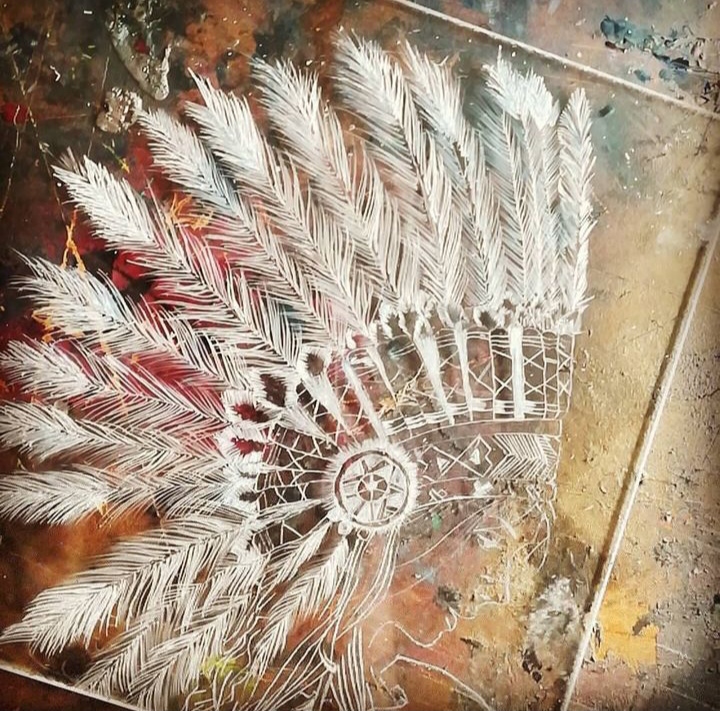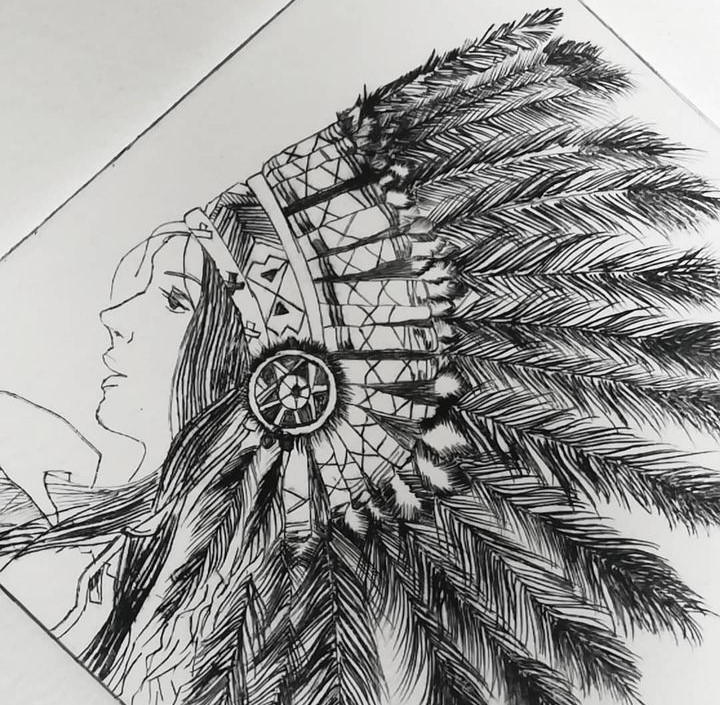Drypoint printmaking is an intaglio printing process. In drypoint, artists create an image by scratching or engraving lines directly into a metal or plastic plate using a sharp, pointed tool. The process derives its name from the fact that it uses no acids or chemicals, unlike other intaglio techniques like etching and aquatint.
Drypoint printing offers versatility, enabling artists to create various effects. Artists can combine this technique with other printmaking methods like etching or aquatint to achieve different results.
People know Drypoint prints for their rich, textured lines and distinctive, expressive quality. Typically, artists make these etching plates from materials such as copper, zinc, or plexiglass. The fragility of the burr limits the number of high-quality prints that artists can produce from a single plate, making each print unique and potentially more valuable.
It is an easy technique to get to grips with and is a great method if you would like to take your drawings into print. It’s easier than etching as it requires less specialist equipment and no chemicals or acids.
Drypoint Printing Process
The drypoint etching is an intaglio printing process that also contains different and unique steps just like other printmaking methods.
Preparing the Drypoint Plate
The very first step is to select a desired material plate and prepare it by properly cleaning its surface and smoothing its edges. You can create a smooth surface by burnishing it with a fine tool or sandpaper.
Drawing the Image
An artist uses a needle or a similar pointed drypoint etching tool to draw or scratch the image onto the drypoint plate. The pressure applied when scratching creates a burr or ridge of displaced metal along the edges of the incised lines.
Inking the Plate
The plate’s surface is then applied with ink, and the excess ink is wiped away, leaving ink only in the incised lines and the burr created during the scratching process. The ink sticks to both the lines and the burr, creating a rich, textured quality to the printed image.
Printing
Place the inked plate on an etching press machine, and lay a sheet of dampened paper on top of it. Run the plate and paper through the press under pressure to transfer the ink from the plate to the paper.
Repeating the Process
Multiple prints can be made from a single plate, but the quality of the image may gradually decrease as the burr wears down with each impression. Artists may choose to re-ink the plate to maintain the richness of the lines.
Benefits of Drypoint Printmaking
The printmaking technique offers several benefits for printmaking artists, here are some of the key advantages.
Direct and Intimate Process
The process allows the artists to work directly on the printing plate, usually made of metal or plastic. This directness fosters a close connection between the artist and the image, enabling them to make subtle and expressive marks with ease.
Versatility
Artists can use drypoint, a versatile technique, in various combinations with other printmaking methods like etching or aquatint to achieve a wide range of textures and effects. This versatility allows for creative experimentation and exploration.
Rich Tonal Range
The Technique is known for its ability to create a rich tonal range. The pressure applied when incising the plate results in a burr, which holds ink and prints as soft, velvety lines and tones. It helps the Artists to achieve a broad spectrum of greys and a wide variety of textures.
Variable Editions
Since the printing plate gradually wears down with each impression, each print in an edition can have subtle variations, which collectors often find appealing. This variability adds a unique and handcrafted quality to each print.
Reproducibility
This printmaking method allows artists to produce multiple copies of their artwork just like any other printmaking technique, but in this specific technique the ink sticks to both the lines and the burr, creating a rich, textured quality making it an excellent choice for producing limited edition prints. This can help artists reach a wider audience and make their work more accessible to collectors.
Quick Printing Process
Drypoint printing is generally quicker and more direct than some other printmaking methods, such as engraving or mezzotint. Artists can produce prints relatively efficiently, which can be preferable for creating multiple editions or exploring new ideas.
Low Toxicity
It is a nontoxic technique not unlike some other intaglio printmaking techniques, like traditional etching with acid that often involves chemicals. Drypoint may be a preferred option for artists concerned about safety in the studio.


Drypoint Printing Techniques
There are several variations of drypoint printing techniques.
Traditional Drypoint Printing
In traditional, artists scratch an image directly onto a metal plate, often made of copper, zinc, or plexiglass/acrylic. The incised lines they create produce burrs or rough edges, which retain ink when they ink the plate. They subsequently wipe and print the plate, producing the characteristic soft, velvety lines.
Multiple-Plate Drypoint
Artists can create multiple plates, each with different elements of an image, and print them together to create a composite image. This allows for different colors or tonal effects in one print.
Color Drypoint Etching
To add color to drypoint prints, artists use separate plates for each color. They ink each plate with its respective color and print them sequentially, creating a multi-colored image.
A la Poupée
In this technique, an artist inks a single plate with multiple colors by using small inked balls, cotton pads, or other tools to selectively apply different colored inks to specific areas of the plate. The artist then prints the plate, resulting in a print with multiple colors.
Chine-Collé
Chine-Collé is a method where thin pieces of colored or decorative paper are sticks to the printing paper during the printing process. The paper is placed on top of the inked plate, and the pressure from the printing press machine transfers the image to the printing paper while simultaneously attaching the thin colored paper.
Embossed Drypoint
In this variation, little to no ink prints the plate, creating an embossed, three-dimensional effect on the paper. Artists can combine this technique with traditional drypoint to create texture and depth in the print.
What is the difference between Etching and Drypoint?
Etching and drypoint are both techniques used in printmaking, specifically in creating intaglio prints where ink is held in recessed areas of the plate. Both techniques offer unique artistic possibilities and are valued for their distinctive line qualities and textures in printmaking.
Key Differences:
Technique: Etching uses an acid bath to create lines, while drypoint directly scratches the lines into the plate.
Line Quality: Etching tends to produce cleaner, more precise lines, while drypoint lines are often softer and fuzzier due to the burr.
Durability: Drypoint plates wear out faster due to the burr flattening with each print, whereas etching plates can produce more prints before needing re-etching.
Intaglio Printing Techniques
Intaglio printing is a printmaking technique in which an image or design is incised into a surface, and then ink is applied to the incised areas. The ink is transferred to paper or another printing surface, creating a raised image with fine details. This technique is often used for creating high-quality, detailed prints and is commonly associated with processes like etching, engraving, drypoint etching, and aquatint.
The Drypoint etching is a different way of creating an intaglio print. In drypoint, it’s all about fine lines and delicate marks. In etchings grooves, marks and lines are made through the use of chemicals so they can be more prominent. drypoint artist manually scratches into the plate to create rough areas (burr) which hold the ink.
This technique allows for expressive and textured lines and is known for its unique quality compared to other intaglio techniques like etching and engraving. Artists often explore